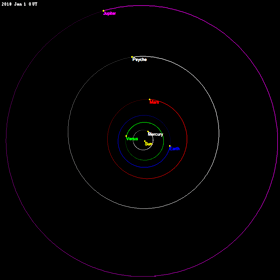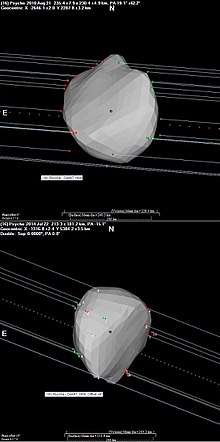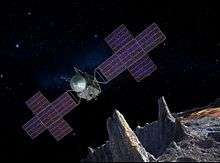16 Psyche
 The orbit of Psyche is near circular, between Mars and Jupiter | |
| Discovery | |
|---|---|
| Discovered by | Annibale de Gasparis |
| Discovery date | 17 March 1852 |
| Designations | |
| MPC designation | (16) Psyche |
| Pronunciation | /ˈsaɪkiː/ SY-kee |
Named after | Psychē |
| none | |
| Main belt | |
| Orbital characteristics[1] | |
| Epoch JD 2453300.5 (22 October 2004) | |
| Aphelion | 3.328 AU (497.884 Gm) |
| Perihelion | 2.513 AU (375.958 Gm) |
| 2.921 AU (436.921 Gm) | |
| Eccentricity | 0.140 |
| 4.99 yr (1823.115 d) | |
| 323.379° | |
| Inclination | 3.095° |
| 150.352° | |
| 228.047° | |
| Physical characteristics | |
| Dimensions | 279 × 232 × 189 km (±10%)[2] |
Mean radius | 113±11.5 km[2] |
| (1.658±0.250)×105 km2 | |
| Volume | (6.074±1.215)×106 km3[2] |
| Mass | (2.72±0.75)×1019 kg[2] |
Mean density | 4500±1400 kg/m3[2] |
Equatorial surface gravity | ~0.29 m/s² |
Equatorial escape velocity | ~180 m/s[2] |
| 4.195948±0.000001 h[2] | |
|
0.15±0.03 0.37±0.09 (radar)[2] | |
|
Tholen = M [1] SMASS = X [1] Bus-DeMeo = Xk [3] | |
| 9.22 to 12.19 | |
| 5.90[1] | |
|
| |
16 Psyche (/ˈsaɪkiː/ SY-kee) is one of the ten most massive asteroids in the asteroid belt. It is over 200 km (120 mi) in diameter and contains a little less than 1% of the mass of the entire asteroid belt. It is thought to be the exposed iron core of a protoplanet.[4] It is the most massive metallic M-type asteroid. Psyche was discovered by the Italian astronomer Annibale de Gasparis on 17 March 1852 from Naples and named after the Greek mythological figure Psyche.[5]
Symbol
The first fifteen asteroids to be discovered were given symbols by astronomers as a type of shorthand notation. Psyche was given an iconic symbol, as were several other asteroids discovered over the next few years. This symbol ![]()
Characteristics
Mass, size and shape
Psyche is massive enough that its gravitational perturbations on other asteroids can be observed, which enables a mass measurement. As of 2017 the best mass estimate is 2.72±0.75×1019 kg.[2][8]

The first size estimate of Psyche came from IRAS thermal infrared emission observations. They showed that it had a diameter of about 253 km,[1] although it was likely an overestimate as Psyche was viewed pole-on at that time.[2]
Light curve analysis indicates Psyche appears somewhat irregular in shape. There is a pronounced mass deficit near the equator at about 90° longitude comparable to Rheasilvia basin on Vesta. There are also two additional smaller (50–70 km in diameter) crater-like depressions near the south pole. that Psyche's north pole points towards either ecliptic coordinates (β, λ) = (−7°, 34°) with a 10° uncertainty.[10] This gives an axial tilt of 95°.[2]
Observations of two multi-chord stellar occultations of 2010 and 2014[11] allow the matching of light curve inversions model DAMIT 1806 that give an equivalent Volume mean diameter of 216+/-12 km, and an equivalent Surface mean diameter of 227 +/- 13 km.
The density of Psyche that follows from size and mass estimates mentioned above – 4500±1400 kg/m³ – is consistent of that of metallic object with a porosity of about 40%.[12] This is higher than most previous estimates.[13][2]
Composition and origin
Radar observations indicate that Psyche has a fairly pure iron–nickel composition,[14][15] consistent with it having one of the highest radar albedos in the asteroid belt (0.37±0.09).[2] Psyche seems to have a surface that is 90% metallic (iron),[16] with small amounts – 6±1% – of orthopyroxene.[17][18]
The NASA Infrared Telescope Facility at the Mauna Kea Observatories released evidence (~3 μm absorption feature) of the presence of water or hydroxyl ions on the asteroid in October 2016. The water is believed to have reached Psyche via past impacts from smaller asteroids containing volatile substances such as carbon, hydrogen and water.[19][20][21][22]
Based on its composition Psyche appears to be an exposed metallic core or a fragment of a metallic core[17] from a larger differentiated parent body some 500 kilometers in diameter. If Psyche is indeed one, there could be other asteroids on similar orbits. However, Psyche is not part of any identified asteroid family.[23] One hypothesis is that the collision that formed Psyche occurred very early in the Solar System's history, and all the other remnants have since been ground into fragments by subsequent collisions or had their orbits perturbed beyond recognition. However, this scenario is considered to have a probability of just 1%. An alternative is that Psyche was broken by impacts, but not catastrophically torn apart. In this case, it may be a candidate for the parent body of the mesosiderites, a class of stony–iron meteorites.[23]
Another possibility is that Psyche may be an endmember of diverse relic bodies left by the inner planet formation. The asteroid's mantle may have been stripped away not by a single collision but by multiple (>3) relatively slow hit-and-run collisions with bodies of comparable or larger size. What is left is a metallic core covered by thin layer of silicates, which reveal itself spectrally. In such a case Psyche would be analogous to Mercury but much less massive.[24]
Exploration

No spacecraft has visited Psyche, but in 2014 a mission to Psyche was proposed to NASA.[25][26] A team led by Lindy Elkins-Tanton,[4] the director of the School for Earth and Space Exploration at Arizona State University, presented a concept for a robotic Psyche orbiter. This team argued that 16 Psyche would be a valuable object for study because it is the only metallic core-like body discovered so far.[26]
The spacecraft would orbit Psyche for 20 months,[25] studying its topography, surface features, gravity, magnetism, and other characteristics and would be based on current technology, avoiding high cost and the necessity to develop new technologies. On September 30, 2015, the Psyche orbiter mission was one of five Discovery Program semifinalist proposals.[27]
The mission was approved by NASA on January 4, 2017 and was originally targeted to launch in October 2023, arriving at the asteroid in 2030, following an Earth gravity assist spacecraft maneuver in 2024 and a Mars flyby in 2025.[28] In May 2017 the launch date was moved up to target a more efficient trajectory, launching in 2022 and arriving in 2026 with a Mars gravity assist in 2023.[29]
References
- 1 2 3 4 5 "JPL Small-Body Database Browser: 16 Psyche" (2008-09-19 last obs). Retrieved 2008-12-04.
- 1 2 3 4 5 6 7 8 9 10 11 12 13 Sheppard, Michael K.; Richardsonb, James; Taylor, Patrick A.; et al. (2017). "Radar observations and shape model of asteroid 16 Psyche". Icarus. 281: 388–403. Bibcode:2017Icar..281..388S. doi:10.1016/j.icarus.2016.08.011.
- ↑ "EAR-A-5-DDR-TAXONOMY-V6.0". Planetary Data System.
- 1 2 Elkins-Tanton, L. T.; et al. (March 2014). "Journey to a Metal World: Concept for a Discovery Mission to Psyche" (PDF). LPI Contribution No. 1777. 45th Lunar and Planetary Science Conference. p. 1253. Bibcode:2014LPI....45.1253E. Retrieved 2015-10-05.
- ↑ Schmadel, Lutz D. (2012). Dictionary of Minor Planet Names (6th ed.). Springer Science & Business Media. pp. 14–15. ISBN 3642297188.
- ↑ Sonntag, A. (1852). "Elemente und Ephemeride der Psyche". Astronomische Nachrichten. 34 (20): 283. Bibcode:1852AN.....34..283.. doi:10.1002/asna.18520342010.
(in a footnote) Herr Professor de Gasparis schreibt mir, in Bezug auf den von ihm März 17 entdeckten neuen Planeten: "J'ai proposé, avec l'approbation de Mr. Hind, le nom de Psyché pour la nouvelle planète, ayant pour symbole une aile de papillon surmontée d'une étoile."
- ↑ Hilton, James (2001-09-17). "When Did the Asteroids Become Minor Planets?". U.S. Naval Observatory. Archived from the original on 2010-01-18. Retrieved 2007-04-03.
- ↑ Baer, Jim (2011). "Recent Asteroid Mass Determinations". Personal Website. Retrieved 2012-04-14.
- ↑ Lupishko, Dmitrij F. (2006). "On the bulk density and porosity of M-type asteroid 16 Psyche". Solar System Research. 40 (3): 214–218. Bibcode:2006SoSyR..40..214L. doi:10.1134/S0038094606030051.
- ↑ Kaasalainen, M.; et al. (2002). "Models of Twenty Asteroids from Photometric Data" (PDF). Icarus. 159 (2): 369. Bibcode:2002Icar..159..369K. doi:10.1006/icar.2002.6907. Archived from the original (PDF) on 2008-02-16. Retrieved 16 May 2006.
- ↑ "Asteroid Data Sets". sbn.psi.edu. Retrieved 2018-05-26.
- ↑
- ↑
- ↑ Ostro, S. J. (1985). "Radar observations of asteroids and comets". Publications of the Astronomical Society of the Pacific. 97: 877. Bibcode:1985PASP...97..877O. doi:10.1086/131619.
- ↑ Magri, C.; et al. (1999). "Mainbelt Asteroids: Results of Arecibo and Goldstone Radar Observations of 37 Objects during 1980–1995" (PDF). Icarus. 140 (2): 379. Bibcode:1999Icar..140..379M. doi:10.1006/icar.1999.6130.
- ↑ Callahan, Jason (March 30, 2015). "Discovery lives". The Space Review. Retrieved 30 March 2015.
- 1 2 Hardersen, Paul S.; Gaffey, Michael J. & Abell, Paul A. (2005). "Near-IR spectral evidence for the presence of iron-poor orthopyroxenes on the surfaces of six M-type asteroids". Icarus. 175 (1): 141. Bibcode:2005Icar..175..141H. doi:10.1016/j.icarus.2004.10.017.
- ↑ Sanchez, Juan;; Reddy, Vishnu; Shepard, Michael K.; Thomas, Cristina; Cloutis, Edward (2016). Compositional characterization of asteroid (16) Psyche. DPS meeting #48. Bibcode:2016DPS....4832520S.
- ↑ Atkinson, Nancy. "Pure Metal Asteroid Has Mysterious Water Deposits". Universe Today. Retrieved 11 November 2016.
- ↑ Simpson, Julia. "Giant Metallic Asteroid Psyche May Have Water". Politicallore. Retrieved 12 November 2016.
- ↑ Jesse Emspak (October 27, 2016). "Giant Metallic Asteroid Psyche May Have Water". space.com. Retrieved 2017-09-18.
- ↑ Takir, Driss; Reddy, Vishnu; Sanchez, Juan A.; Shepard, Michael K.; Emery, Joshua P. (2016). "Detection of Water and/or Hydroxil on Asteroid (16) Psyche". The Astronomical Journal. 153: 31. arXiv:1610.00802. Bibcode:2017AJ....153...31T. doi:10.3847/1538-3881/153/1/31.
- 1 2 Davis, D. R.; Farinella, Paolo & Francesco, M. (1999). "The Missing Psyche Family: Collisionally Eroded or Never Formed?". Icarus. 137 (1): 140. Bibcode:1999Icar..137..140D. doi:10.1006/icar.1998.6037.
- ↑ Asphaug, E.; Reufer, A. (2014). "Mercury and other iron-rich planetary bodies as relics of inefficient accretion". Nature Geoscience. 7 (8): 564–568. Bibcode:2014NatGe...7..564A. doi:10.1038/NGEO2189.
- 1 2 Chang, Kenneth (6 January 2017). "A Metal Ball the Size of Massachusetts That NASA Wants to Explore". The New York Times. Retrieved 7 January 2017.
- 1 2 Wall, Mike (15 January 2014). "Strange Metal Asteroid Targeted in Far-Out NASA Mission Concept". Space.com. TechMedia Network. Retrieved 16 January 2014.
- ↑ Brown, Dwayne C.; Cantillo, Laurie (September 30, 2015). "NASA Selects Investigations for Future Key Planetary Mission". NASA TV. NASA. Retrieved 2015-10-05.
- ↑ Northon, Karen (2017-01-04). "NASA Selects Two Missions to Explore the Early Solar System". NASA. Retrieved 2017-01-04.
- ↑ "NASA Moves Up Launch of Psyche Mission to a Metal Asteroid". NASA. 2017-05-24. Retrieved 2017-05-24.
External links
- Shape model deduced from lightcurve
- 16 Psyche at AstDyS-2, Asteroids—Dynamic Site
- 16 Psyche at the JPL Small-Body Database
